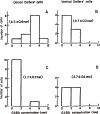Synaptic inhibition and γ-aminobutyric acid in the mammalian central nervous system
- PMID: 23574805
- PMCID: PMC3669732
- DOI: 10.2183/pjab.89.139
Synaptic inhibition and γ-aminobutyric acid in the mammalian central nervous system
Abstract
Signal transmission through synapses connecting two neurons is mediated by release of neurotransmitter from the presynaptic axon terminals and activation of its receptor at the postsynaptic neurons. γ-Aminobutyric acid (GABA), non-protein amino acid formed by decarboxylation of glutamic acid, is a principal neurotransmitter at inhibitory synapses of vertebrate and invertebrate nervous system. On one hand glutamic acid serves as a principal excitatory neurotransmitter. This article reviews GABA researches on; (1) synaptic inhibition by membrane hyperpolarization, (2) exclusive localization in inhibitory neurons, (3) release from inhibitory neurons, (4) excitatory action at developmental stage, (5) phenotype of GABA-deficient mouse produced by gene-targeting, (6) developmental adjustment of neural network and (7) neurological/psychiatric disorder. In the end, GABA functions in simple nervous system and plants, and non-amino acid neurotransmitters were supplemented.
Figures






Similar articles
-
The role and the mechanism of gamma-aminobutyric acid during central nervous system development.Neurosci Bull. 2008 Jun;24(3):195-200. doi: 10.1007/s12264-008-0109-3. Neurosci Bull. 2008. PMID: 18500393 Free PMC article. Review.
-
Co-localization of Gamma-Aminobutyric Acid and Glutamate in Neurons of the Spider Central Nervous System.Cell Tissue Res. 2015 Dec;362(3):461-79. doi: 10.1007/s00441-015-2241-5. Epub 2015 Jul 22. Cell Tissue Res. 2015. PMID: 26197966
-
Is there more to GABA than synaptic inhibition?Nat Rev Neurosci. 2002 Sep;3(9):715-27. doi: 10.1038/nrn919. Nat Rev Neurosci. 2002. PMID: 12209120 Review.
-
Immunocytochemical localization of glutamic acid decarboxylase in normal and deafferented superior colliculus: evidence for reorganization of gamma-aminobutyric acid synapses.J Neurosci. 1983 Oct;3(10):2030-42. doi: 10.1523/JNEUROSCI.03-10-02030.1983. J Neurosci. 1983. PMID: 6619922 Free PMC article.
-
GABAB receptor-mediated modulation of metabotropic glutamate signaling and synaptic plasticity in central neurons.Adv Pharmacol. 2010;58:149-73. doi: 10.1016/S1054-3589(10)58007-4. Adv Pharmacol. 2010. PMID: 20655482 Review.
Cited by
-
The Exometabolome of Xylella fastidiosa in Contact with Paraburkholderia phytofirmans Supernatant Reveals Changes in Nicotinamide, Amino Acids, Biotin, and Plant Hormones.Metabolites. 2024 Jan 24;14(2):82. doi: 10.3390/metabo14020082. Metabolites. 2024. PMID: 38392974 Free PMC article.
-
GABA Receptors and Kv7 Channels as Targets for GABAergic Regulation of Acetylcholine Release in Frog Neuromuscular Junction.Neurochem Res. 2024 Nov 20;50(1):25. doi: 10.1007/s11064-024-04274-x. Neurochem Res. 2024. PMID: 39562376
-
Gut microbiota: a potential influencer of insomnia occurring after COVID-19 infection.Front Psychiatry. 2024 Jul 23;15:1423715. doi: 10.3389/fpsyt.2024.1423715. eCollection 2024. Front Psychiatry. 2024. PMID: 39109368 Free PMC article. Review.
-
Anticonvulsant effects of ivermectin on pentylenetetrazole- and maximal electroshock-induced seizures in mice: the role of GABAergic system and KATP channels.Heliyon. 2022 Nov 2;8(11):e11375. doi: 10.1016/j.heliyon.2022.e11375. eCollection 2022 Nov. Heliyon. 2022. PMID: 36387449 Free PMC article.
-
Natural Medicines for the Treatment of Epilepsy: Bioactive Components, Pharmacology and Mechanism.Front Pharmacol. 2021 Mar 4;12:604040. doi: 10.3389/fphar.2021.604040. eCollection 2021. Front Pharmacol. 2021. PMID: 33746751 Free PMC article. Review.
References
-
- Sherrington, C.S. (1906) The Integrative Action of the Nervous System. Yale Univ. Press, New Haven, CT, pp. 1–413.
-
- Granit, R. (1967) Charles Scott Sherrington an Appraisal. Doubleday & Co., Garden City, NY, pp. 1–188.
-
- Eccles, J.C. (1964) The Physiology of Synapses. Springer, Berlin, pp. 1–316.
-
- Finger, S. (1994) Origins of Neuroscience. Oxford Univ. Press, New York, NY, p. 47.
-
- Setchenov, I.M. (1863) Reflexes of the Brain. (Russian pamphlet).
Publication types
MeSH terms
Substances
LinkOut - more resources
Full Text Sources
Other Literature Sources

